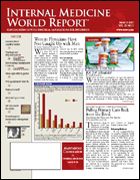Diabetes Self-Care Compromised by Chronic Pain
Diabetes Self-Care Compromised by Chronic Pain
By Jill Stein
More than 50% of patients with diabetes experience chronic pain, data from a new study (Diabetes Care. 2005;28:65-70) indicate. And, as if living with chronic pain is not bad enough, its presence has now been shown to strongly interfere with patients’ ability to manage their diabetes, including such physician-recommended tasks as following an exercise program or a special diet.
“These findings emphasize the importance of considering potential competing demands, such as chronic pain, when developing self-care regimens for patients with diabetes or other chronic health conditions that require high levels of self-management,” wrote Sarah L. Krein, RN, PhD, of the VA Healthcare System, Ann Arbor, MI, and colleagues.
Although pain is often the key symptom that prompts patients to seek medical care and is also responsible for a significant percentage of job absenteeism in the United States, there is little information on how chronic pain affects patients with comorbid chronic conditions.
Previous studies had not looked at whether chronic pain is a barrier to performing recommended diabetes self-management practices.
For this study, information on chronic pain and diabetes self-management was obtained through a survey of 993 patients with diabetes who were being treated by the VA system. Chronic pain was defined as pain that was present for most of the time for ³6 months during the preceding year.
Diabetes self-management was evaluated by asking patients to indicate their difficulty with and ability to perform key self-care practices that had been recommended by their physician.
Overall, 557 respondents (60%) reported chronic pain. Patients with chronic pain were more likely to be younger, women, insulin users, and have excess body mass index.
Nearly one third of patients who described chronic pain maintained that their pain was severe or very severe during the past 4 weeks, and about three quarters said they sometimes or regularly used pain relievers. The back, hips, or knees were the sites most often affected.
Patients with chronic pain had poorer diabetes self-management overall (P = .002) and more difficulty adhering to a recommended exercise program (adjusted odds ratio [OR] = 3.0) or eating plan (OR = 1.6). Patients with severe pain said they found it more difficult to take diabetes medications (OR = 2.0) or to exercise (OR = 2.5).
“Our data underscore the importance of identifying other conditions, such as chronic pain, that can make it difficult for patients to engage in recommended diabetes self-management practices,” Dr Krein told IMWR. “In addition, physicians may need to provide more tailored recommendations or additional assistance to patients with chronic pain, or other competing conditions, to better support and improve their diabetes self-care.”
Dr Krein’s group is currently examining the effect of chronic pain on care delivery and outcomes for patients with diabetes and is also conducting a survey of primary care physicians that focuses on chronic pain management, particularly in patients with other chronic conditions, such as diabetes.
